Welcome back to another furtive rummage through the back-catalog of the Bandai WonderSwan: a Japanese-only handheld that existed briefly in the gap between the Game Boy Color and the Game Boy Advance, with technology boasting that of the latter if not always the color palette. Last episode felt like the series finally "landing", accomplishing the early stages of two goals I had in mind when crafting the outline for this feature: seeing what kind of output Squaresoft had on the system after embracing it as an alternative to Nintendo, to whom they were formerly loyal until a big falling out, as well as encountering the first WS game I was intrigued enough with to see it through to its end. We have more of both this time but I suspect there won't be too much of either in the updates to come; even so, those will be the highlights I'm personally anticipating. For anyone else, I'm sure the highlights instead will be those times I come up against a truly inscrutable anime tie-in and flounder around helplessly with the Japanese menus for ten minutes before calling it quits. Well, depending on your temperament and appreciation for watching others suffer, I suppose (I feel like Blight Club being as popular as it is has turned the site's audience onto a dark, sadistic path).
Speaking of sadistic, my continued negotiations with the Random Chooser Unnion* are progressing swimmingly. In AHW Part Two I managed to secure the "Lucky 7s Clause", in which I could switch every seventh entry from a random selection to one of my own choosing. I've just now procured another boon in the "Prime Plus Plan": from this entry onwards, I also have full jurisdiction over every prime-numbered entry. There are no numbers between 16-20 that are divisible by seven, but both 17 and 19 are primes so I've substituted a few wanted games of my own in there. And to think, all it cost me was full healthcare and dental plans for all employees. Pfft, peanuts. I'll be sure to keep working my bargaining magic over these blue-collar rubes in the entries to come, provided I even bother to show up to the meetings. Truly a leader conscientious of his workforce.
*I can't spell this word properly or else the whole blog errors out for some reason. Hmmmmmmmmmmm.
If you're looking for more WonderSwan goodness be sure to check out the past entries here: Part One, Part Two, and Part Three.
#016: Final Fantasy

- Developer: Squaresoft
- Publisher: Squaresoft
- Release Date: 2000-12-09
- Inscrutability: Minor (with the partially-complete fan translation)
- Selection Process: Random.
- Is This Anime?: It's so close.
Field Report: The first Final Fantasy famously pulled Square's butt out of the fire when its financial outlook appeared bleak, kicking off a turn-based RPG franchise that would eventually prove to be the company's most identifiable flagship and main source of revenue, especially once the MMOs started showing up. However, Final Fantasy 1 feels a bit prototypical compared to what followed, with a basic (if somehow also convoluted) story outline that saw four interchangeable "Warriors of Light" attempt to halt a series of natural disasters by defeating a quartet of elemental lords and the evil god of Chaos that controlled their actions from the distant past. As with any party-based D&D game, from which Final Fantasy is indirectly sourced (going through a few inspiration intermediaries like Wizardry and The Black Onyx), party composition and balance is important though veteran players often like to challenge themselves with unorthodox and impaired combinations.
This would've been the last revision for Final Fantasy 1 before its 2002 reappearance on PlayStation as part of the Final Fantasy Origins compilation (and, soon after, Final Fantasy I & II: Dawn of Souls for Game Boy Advance), and it turns out the graphical facelift it saw in FF Origins actually came from this version of the game. Not only are the sprites remastered to resemble those from the 16-bit games but they also added backgrounds to combat scenes (it was just a void before) and other aesthetic enhancements everywhere you looked. I'd assumed that Square throwing together a FF1 port (their simplest RPG, if you don't count Mystic Quest) was just a quick means of testing out the hardware and seeing if the WonderSwan was a good fit for them, but they put a lot more effort into this remake than I gave them credit for.


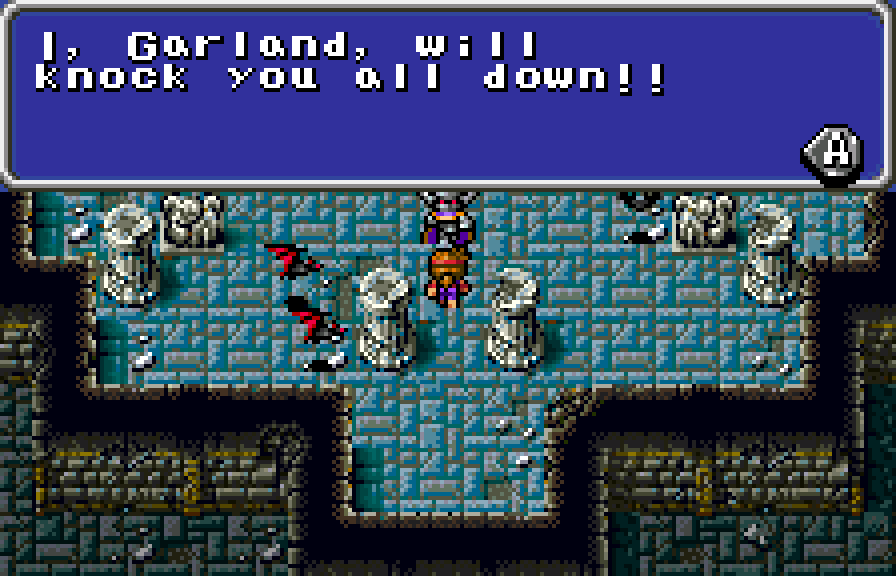
Since the only fan translation that exists for the WonderSwan port of FF1 is an incomplete one, I decided to do the intelligent thing of assembling a party entirely out of Black Belts (or Monks, going by the translation) so I wouldn't have to tinker around in my inventory too often in case none of the items or equipment were translated (they were). What I forgot about is that Black Belts are kinda weak at the start (and also the middle, and also towards the end) so there was a whole lot of buff men grinding in the forest, as it were, before I felt prepared enough to take on Garland at the Chaos Shrine to the far northwest of Corneria. Incidentally, if you are interested in the full plot of Final Fantasy 1 then I highly recommend playing Stranger of Paradise, which is a faithful retelling that doesn't do anything weird with it whatsoever.
After powering up enough where my attacks weren't just whiffing half the time I marched into that shrine, rescued the princess from the curiously weak Garland, and set off to the nearby town of Pravoka to deal with their pirate problem. The pirates weren't tough at all; however, the random encounters on the world map in the Pravoka region were a different tale altogether. We started meeting these huge ogres that hit like a freight train and groups of four "MadPony", which are one of the earliest enemies that are capable of attacking multiple times a round. Good XP and cash from both though, and since Black Belts don't need to save up for equipment too often (with a few exceptions, mostly of the accessory kind) I made sure to keep myself replete with curatives. At any rate, I remembered that the next dungeon after acquiring the pirate ship was one that had a lot of poison-type enemies and I wasn't prepared to go through all that again, especially with no healers on my team. I've completed this game before after all—via the Dawn of Souls remake, in fact—so this was mostly just a quick visit to see what was different. I will say that the game does look pretty good: even the SNES port didn't look this sharp, though of course the more popular GBA and PS1 ports that soon followed stole most of the glory from this version's graphical updates. There were also some much-needed QoL additions too, like party members attacking other enemies if their chosen target had already been slain and a clear indicator of who could wear what and how they'd benefit stats-wise from switching gear. Still, it was mostly the same old Final Fantasy 1 as ever: a bit grindy and dull but worth seeing through at least once if you're a fan of the franchise, if only to see how far it's come since.
Time Spent: Just shy of 90 minutes.
#017: Rainbow Islands: Putty's Party

- Developer: DigitalWare
- Publisher: Megahouse
- Release Date: 2000-06-29
- Inscrutability: None (Fan Translated)
- Selection Process: Chosen (Prime Plus Plan).
- Is This Anime?: Nah.
Field Report: Taito's Rainbow Islands is the sequel, sorta, to Bubble Bobble and shifts the action from blowing bubbles at monsters in single-screen stages to ascending a vertical level with rainbows that can be walked upon or used to trap and defeat enemies. Bub and Bob also return to the starring roles but are back in their original human forms as Bubby and Bobby. As in Bubble Bobble, there's a moderately high level of challenge that can be mitigated if you know the game's secrets, the most important of which if you want the good ending involves spawning and collecting seven gems of the color spectrum in each of the game's worlds. Putty's Party is a spin-off, or sequel, or maybe like an alternative timeline game (think the other modes in some Castlevanias where you're controlling a different character), where you're instead playing as Patty: one of the two heroines Bub and Bob set out to save in Bubble Bobble. I'm not sure what else has changed but I guess we'll find out.
Despite being another Taito game there's no trace of them anywhere around this particular WonderSwan port/reimagining. Instead, we have DigitalWare and Megahouse, neither of which I know too much about. DigitalWare is a developer that worked in a supporting role for a great many games, though few that have been verified by GDRI, and this was the only WonderSwan game they were ever attached to. It sounds like they might've done the brunt of the programming and graphics but had other contractors pitch in on everything else. Megahouse is, I'm fairly sure, one of several publishing labels that Bandai used along with Angel and others. They're also the publishers for one other WonderSwan game: Tetsujin 28-go, an adventure game based on the very early (we're talking 1950s) mecha manga that was known in the States as Gigantor. Man, the tangents we go off on sometimes.



Disclaimer: I'm one of those weirdos who likes Rainbow Island more than Bubble Bobble, partly because traversal with those awkward mostly-vertical jumps isn't anywhere near as difficult when you can create your own platforms (well, sure, you can jump off your own bubbles too in Bubble Bobble but it's not ideal). The game's little cutscenes aren't just an excuse for ditzy tomboy protagonist Patty and her tsundere fairy familiar Notti to be all cute: one of the first few tells you important information about how the big diamonds work. Chiefly, that you have to collect seven gems per world by defeating enemies at various longitudes—that is to say, the vertical slice of the screen where the corpse lands determines what color gem you get, from red at the far left to violet at the far right, or in this game's case a darkish gray and a slightly darker gray. Yeah, I guess it needs pointing out that a game about rainbows is kind of a bad fit for a monochrome system but the "color" depth is higher than the Game Boy so they can still give each of those gems their own distinctive(ish) shade of gray at least.
Chalk this up as another game I was able to complete before writing this review, since the game is relatively short at just five worlds with four stages apiece, as opposed to the seven worlds (or ten, including secret ones) of the original Rainbow Islands. The stages always followed a similar pattern of two normal stages, followed by an "event" stage—for the odd-numbered worlds you had to quickly ascend to escape a rising tide, usually the result of spending too long in any one level, while the even-numbered worlds had you hunt down a secret door by firing rainbows everywhere—which is then followed by the final stage complete with boss fight. Most bosses can be defeated quickly by spamming rainbows at them, though they won't flinch at all so you do still need to anticipate their movements to not get caught by them. As for the differences between this and regular Rainbow Islands, there's quite a few significant new features: the biggest change allows you to enter a secret door after completing a world with the big diamond, the result of finding all seven rainbow gems, and the item within gives you a permanent power-up (double-rainbows, faster rainbows, faster Patty, or some cheat-like wings that let you fly past the level). You can also summon Notti with a specific item, and he'll circle around you like an option in a shoot 'em up and insta-kill anything he touches. Naturally, the other big change is the switch in focus to Patty and Notti, and in addition to the many small cutscenes there's multiple endings to earn based on how meticulous you were about those big-ass diamonds. Pretty standard take on an arcade classic but one with enough new features to feel both more modern (for 2000 standards, anyway) and distinct enough from other ports to draw in all the Rainbow Island diehards. Not that there can't be too many of those roaming around.
Time Spent: It took 90 minutes to beat the game with the best ending. It'll take a lot longer to get all those RetroAchievements though.
#018: Shin Nihon Pro Wrestling: Toukon Retsuden

"New Japan Pro Wrestling: Furious Legend"
- Developer: TOSE
- Publisher: Tomy
- Release Date: 1999-03-04 (launch)
- Inscrutability: Maximum. On two levels.
- Selection Process: Random.
- Is This Anime?: Wrestling is essentially anime, so yes.
Field Report: Shin Nihon Pro Wrestling: Toukon Retsuden is a NJPW wrestling game from Yuke's that happens to be the first game they ever made. Yuke's would later become renowned (if that's the word) for being the custodians of the annual WWE game franchise but they started with the local NJPW circuit and produced the first Toukon Retsuden for PlayStation in 1995, following it with three sequels. Western wrestling fans might know Toukon Retsuden by a different name: Power Move Pro Wrestling, with publishers Activision choosing to toss out all the NJPW talent and substitute in their fictional own. Naturally, squeezing a PS1 game onto a portable meant some cuts here and there but it otherwise seems faithful enough. It's also the third of the four WonderSwan launch games we've covered on here so far (and I fully intend to cover the last of those in due time, since it's Final Fantasy-related).
Of course, I say it's a Yuke's game but it appears as if assiduous contractors TOSE were given the honors of figuring out how to squash a CD game onto a tiny 1MB cart. TOSE would develop 14 WonderSwan and WonderSwan Color games in total, making them the most prolific third-party developer on the platform. Still, 14 games is a mere drop in the bucket for a developer purported to have worked on thousands during their long tenure; they're a seriously impressive group, even if many of the games themselves aren't quite as remarkable. No clue why toy manufacturer Tomy is here, but they were the PS1 game's Japanese publishers also; maybe they had licensing rights for NJPW figures and that included video games too? I suppose that's all the procrastinating I can get away with, so let's boot up this dang ol' wrestling game and I'll try to make as much sense of it as I'm able. Good thing there's only three games of this genre on the system (and one is a Kinnikuman game, which I'll have no problems with at all).


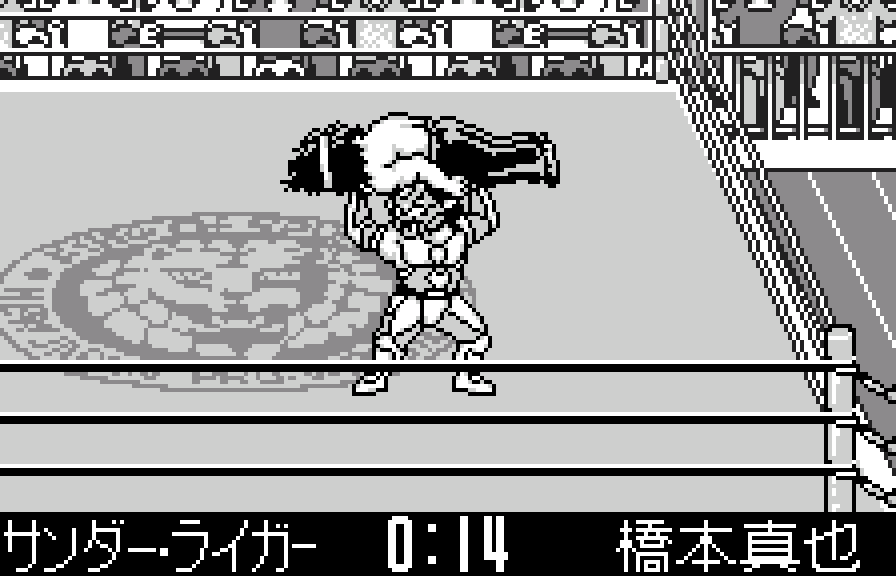
I mean... this went about as well as can be predicted. As you can see from the screenshots, we have a traditional perspective of the ring as opposed to FirePro's more diamond-shaped affairs and the wrestlers—of which there appears to be only six, though maybe there's some unlockables or boss characters—are rendered in a top-heavy chibi style to better suit the limited confines of the WonderSwan. The WS has several face buttons yet I could only get the basic attack and grapples to work: maybe there's a whole "direction plus face button" system involved to access the various piledrivers and DDTs but I'll admit to not being in any big rush to figure this game out.
I managed to get into two bouts, lost both of them, and called it quits there. There's not going to be an onboarding process for newbies and even if there was it'd all be in a language I can barely read. There are multiple modes on the main menu, all thankfully written in katakana: Title Match (exhibition), G1 Climax (a round robin tournament), Time Attack (didn't try it, but maybe "pin the guy in under X minutes"?), something called "Toshi Ichi-Ningu" which is maybe a two-on-one match?, and the Options (which had a sound test, if you wanted to hear a bunch NJPW entrance theme MIDIs). I tried out the first two of those but besides the set-up there wasn't much different about the matches themselves. I dunno, I don't feel equipped to render judgment on a wrestling game even when it's in English so I was pretty lost here. Luck of the draw, I suppose.
Time Spent: 10 minutes.
#019: O-Chan no Oekaki Logic

"O-Chan's Picture Logic"
- Developer: Santaclaus
- Publisher: Sunsoft
- Release Date: 2000-01-06
- Inscrutability: Minor.
- Selection Process: Chosen (Prime Plus Plan).
- Is This Anime?: Looks like Sanrio, but ain't.
Field Report: O-Chan no Oekaki Logic is a picross/nonogram game featuring characters from Sunsoft's recurring mascot team that debuted in the NES game Hebereke (Ufouria: The Saga in North America) and later made frequent appearances in games on the SNES and PlayStation also. O-Chan, a girl in a cat kigurumi, is the second member of the group after Hebe (a penguin) and she personally headlines the Oekaki Logic (Picture Logic) picross spin-off series, of which there's at least three entries. (What complicates matters here is that there's an "Oekaki Logic 1" for SNES, WonderSwan, Saturn, and PS1 and I'm not sure if they're all the same game or not. They each have some unique features and a different total number of puzzles, for what it's worth.) If you're unfamiliar with picross and might want a more thorough tutorial than I can provide here, there's plenty of great picross games out there to get started with including the original two Mario's Picross games (GB and SNES) available through the Switch Online service as well as Jupiter's Picross S series on Switch and numerous games on Steam (I recommend either Pepper's Puzzles or Paint it Back!).
Hebereke creators Sunsoft are of course our publishers here, though sadly this is the only game they published on WonderSwan that was either picross- or Hebereke-related. They worked on three other games, developing two themselves, including some Taito ports and a portable iteration of the Shanghai mahjong solitaire series that they originally licensed from Activision. The festively-named developers Santaclaus was a Sunsoft subsidiary that would go on to chiefly focus on browser and mobile games. One of their few big releases was the surreal airborne arcade fighter Astra Superstars in 1998. This would be their only WonderSwan project.



Total comfort pick, this one. I love picross and this is the only picross game on the system. I've played the original O-Chan no Oekaki Logic on Super Famicom but it's been so long that I don't recall any of the puzzles, so I'll just assume for the sake of my own sanity that I'm not just playing through them all again. This game uses the "Wario Mode" ruleset which eventually became the more popular choice for picross game developers. To explain what that is, in the Mario's Picross games (which were more or less the first of their type, unless there's some older obscure PC game I'm unaware of) you had two sets of puzzles hosted by Mario and Wario respectively. Mario's ruleset involved the instant correction of errors, usually inducing a time penalty or some other black mark to highlight you'd messed up; Wario, however, was happy to let you stew in your own juices if you ever made a mistake but on the plus side never gave out demerits for a simple misclick. Since misclicks are extremely common once you're in the flow of things, the laissez-faire Wario approach proved to be the more endearing one (I'm sure he'd be satisfied knowing that given their rivalry).
There's a remarkable 300 puzzles in the regular puzzle mode, spread across four difficulties and grid sizes ranging from 5x5 to 25x15 (which is realistically about all the WonderSwan screen could handle without some awkward screen-scrolling tech). This version of the game also has a "Versus" mode which, as far as I can tell, just involves completing a large 3x3 multi-picross puzzle to reveal an image of your current CPU opponent. There's a time limit in this mode, unlike the core mode, but it's pretty generous at 30 minutes per grid. The game prompts to save after each completed puzzle: I didn't pay attention that the default was on "iie" rather than "hai" (i.e. "no" instead of "yes") so I did lose all the progress I'd made in one session due to that human error, but otherwise I've been happily plugging away at this enormous set since earlier this week and will probably continue to do so for the rest of the month. It's therefore one of the few WonderSwan games that I intend to go back to once I've covered it here. Proof enough that I'm enjoying it I suppose, but that's a near certainty with anything picross.
Time Spent: Let's say 10 hours and counting.
#020: Beatmania for WonderSwan
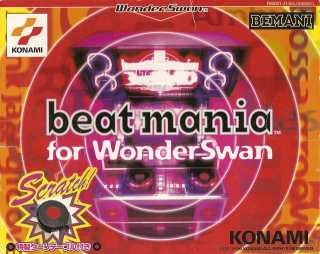
- Developer: Konami
- Publisher: Konami
- Release Date: 1999-04-28
- Inscrutability: Minor.
- Selection Process: Random.
- Is This Anime?: Not at all.
Field Report: Beatmania, or Bemani, is Konami's chief contribution to the arcade rhythm game craze that improved the olfactory quality of those dingy parlors by adding copious amounts of nerd sweat as they frantically shifted their forms to high-BPM Eurobeat and EDM jams. Bemani involved far less awkward stepping than Konami's other big rhythm game series Dance Dance Revolution though; instead, it had budding DJs manipulate a turntable controller to follow the on-screen prompts as best as they were able. Home versions either offered custom controller peripherals to recreate the effect or an alternative control scheme with whatever face buttons were at hand. I feel like such an old person describing all this like it's obscure information given these games hit their peak around 20-25 years ago and have remained consistently popular ever since.
Our first Konami game for WonderSwan is, in fact, the only Konami game for WonderSwan. One Bemani game is all they had in 'em I guess. Maybe the resulting sales figures didn't make sense for them to pursue WS sequels, given the vast number of other platforms beat maniacs had available for all their rhythmic tapping needs. I'm sad we won't get to see some monochrome Metal Gear Ac!d or Ganbare Goemon goodness, but there's a whole bunch of that stuff on Nintendo handhelds if ever the itch should strike.

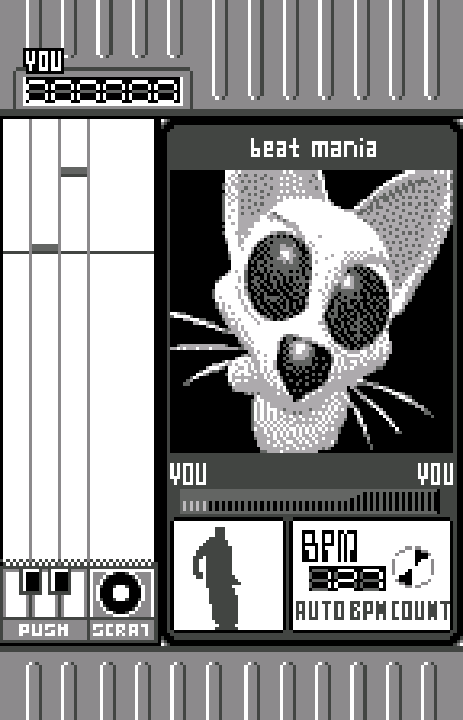
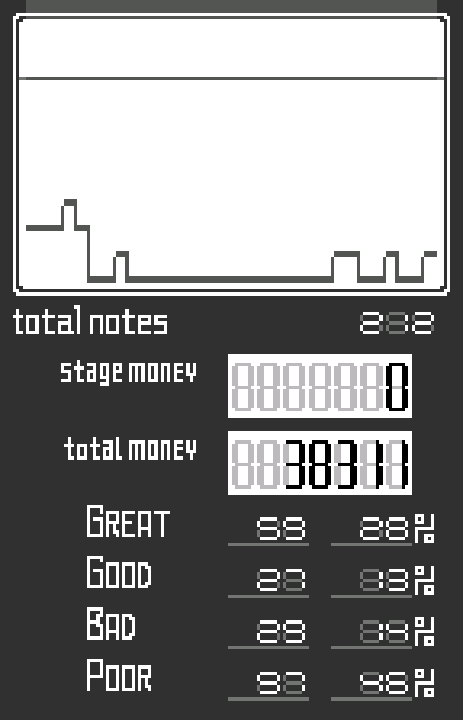
Yeah, I figured out why there weren't more sequels. Beatmania on WS is hard, man. It's not just the usual high-demand rhythm game struggles either but a certain ambiguity towards the controls that make them challenging to remember. You essentially have six lanes that notes float down: five attached to piano keys and one for the turntable (your only goal is to scratch it; I dunno if there's anything more involved in later tracks). The turntable responds to the R-button and the rest are spread across the top three D-pad buttons and face buttons—you get more buttons to work with when the WonderSwan is in its vertical orientation, which it is here in order to be closer to the arcade format—but in a way where it kinda overlaps on the middle key (which is both D-pad right and the left face button) and that's what keeps tripping me up, along with having to do the mental math of how many positions the key is from the left and what button that corresponds to. When the track gets hectic with multiple beats per second it's just too much for my old man brain to handle.
Of course, that demanding on-beat precision has been a factor with Bemani and rhythm games in general since the get-go, but I can usually handle the easier introductory songs with just a few mistakes: here, I couldn't get through either of the initially unlocked tracks, "Funk" and "Ambient" (I wasn't initially sure if those were their names or just their genres or what) without the little dancing man just shrugging woefully at me. The practice mode walked me through what key does what for its first "lesson" but then I guess it skipped a whole semester and immediately drops me into Ambient, which is the harder of those two initial songs with its two-star rating. I figure the game was probably aimed squarely at those already familiar with arcade Bemani and wanted some approximation to play on the go rather than a new audience of would-be turntablists who maybe don't get out to the local arcade much. Still, even if I flamed out spectacularly on this particular portable rhythm game series at least I'll always have the Ouendan on DS (for which I'll point out that I beat all its songs on the hardest setting, since I need some ego-massaging right now).
Time Spent: 20 minutes of pain.
Current Ranking
(* = Don't need fluent Japanese to enjoy this and/or it has a fan translation.)
- O-Chan no Oekaki Logic (Ep 4)*
- Kaze no Klonoa: Moonlight Museum (Ep 3)*
- Final Fantasy (Ep 4)*
- Rainbow Islands: Putty's Party (Ep 4)*
- Flash Koibito-Kun (Ep 1)*
- Magical Drop for WonderSwan (Ep 1)*
- Gunpey (Ep 2)*
- Judgement Silversword -Rebirth Edition- (Ep 1)*
- Final Lap Special (Ep 2)*
- Densha de Go! (Ep 2)
- Gomoku Narabe & Reversi Touryuumon (Ep 3)*
- Guilty Gear Petit (Ep 3)*
- Blue Wing Blitz (Ep 3)
- Beatmania for WonderSwan (Ep 4)*
- Super Robot Taisen Compact for WonderSwan Color (Ep 3)
- Inuyasha: Fuuun Emaki (Ep 1)
- Shin Nihon Pro Wrestling: Toukon Retsuden (Ep 4)
- Meitantei Conan: Nishi No Meitantei Saidai No Kiki!? (Ep 2)
- Metakomi Therapy: Nee Kiite! (Ep 2)
- SD Gundam Eiyuuden: Musha Densetsu (Ep 1)
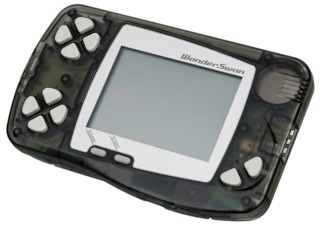
Log in to comment